Ride1Up Vorsa Review | A True Do-It-All?
A multi-purpose powerhouse with loads of customization. The Vorsa has uncommon versatility and showcased an impressive run through our standardized testing.

There are many styles of e-bikes for good reason, but given their cost and space requirements, there’s practicality in finding one that can handle multiple tasks well. That’s exactly what Ride1Up set out to do with the Vorsa.
In our review of the Ride1Up Vorsa, we examined all the ins and outs of the brand’s first “SUV-style” e-bike; this ride is built for commuting, exploring hardpack dirt, and tackling the intense cargo-carrying duties typically reserved for longtails.
From the first ride, it was clear: the Vorsa is a powerhouse. This is one of the fastest Ride1Up bikes I’ve tested, making rides both thrilling and effortless. But what really stood out was its level of control. You can customize a lot—from its top speed and acceleration to its hill-climbing power and even the way it delivers assistance, whether you prefer the natural feel of a torque sensor or the effortless push of cadence sensors.
The Vorsa handles city streets well, with an adjustable stem that helps dial in a comfortable riding position and a narrow handlebar that makes handling feel snappy. Its tires and geometry are also well-suited for exploring milder stretches of off-road terrain. But what makes it truly versatile is its reinforced rear rack, which can support 150 lbs on its own or up to 180lbs with the rack extender. That seriously expands its cargo-hauling potential.
The ride is fun and adaptable to different phases of life or daily demands, though it’s not without a few minor drawbacks. But after collecting all our testing data—and seeing how it outperformed most similar rides we’ve tested in the past few years—those flaws felt negligible.
For all the details from our testing, read the full Vorsa review below.
Class 2 (throttle to 20 mph)
Class 3 (pedal assist to 28 mph)
 Pros
Pros- Motor power & customization. Out of the box, the motor feels great and can flatten the steepest hills for you. You can also lower the power for a milder ride with greater battery range.
- Customization options. You can pick the wattage, torque level, and engagement sensor (torque or cadence) you prefer for the ride you want through the settings menu.
- Highly versatile. This bike works great for commuting and mild off-road adventuring, and even works as a longtail cargo bike with a high weight capacity.
- All-around performance. The Vorsa scored good to great in our standardized tests.
- Terrific value. The Vorsa costs less and is equipped with better tires and brakes than many direct comps.
- iOS GPS tracking is built in for added security.
- Passenger package and other heavy-duty accessories to max out the bike’s cargo rack.
 Cons
Cons- We expect most riders to pick either the torque or cadence sensor and rarely switch, but if you do, there aren’t presets for power profiles, so you’ll want to change the power and torque options for PAS levels each time, too.
- The long seatpost and adjustable stem help, but sizing options are limited to one each for the XR and ST models.
- Battery: 15Ah (720Wh) Samsung 50GB gas vent cells, 133SP 21700 cell formation removable battery with sophisticated software BMS. UL 2271 Certified
- Display: Ride1Up vivid color “most customizable” one-touch OLED display with iOS GPS integration
- Motor: 750W Angled-gear AKM hub motor with 95nm of torque
- Controller: 48V 25A water resistant sine-wave controller
- Headlight: 100 lux front light
- Taillights: Fender-integrated braking light
- Pedal Assist: 5-level PAS, Intui-Drive torque sensor system or R1CBC cadence system
- Claimed Range: 30-60 miles
- Throttle:Thumb lever, modular
- App:N/A
- UL Certification:2849 compliant
- Claimed weight: 70 lbs
- Tested Weight:
- Rear Rack Weight Capacity: 150lb rated semi-integrated modular rack, can expand to 180lbs with attachments
- Rider height range: 5’2 – 6’4”
- Total payload capacity: 440 lbs
- Brakes:Star Union 2-piston hydraulic brakes 203mm R, 180mm L rotors
- Fenders:Front and rear 2.8″ metal alloy fenders
- Fork:Exsho, 100mm coil spring suspension fork with hydraulic lockout
- Frame: Aluminum, one size XR, 1 size ST, three color options
- Drivetrain:Shimano Acera 8-speed, 42t, 11 – 32t cassette
- Grips: VLG ergonomic silicone grips
- Saddle: Velo Black Iron Bow
- Handlebar: Riser bars; 680mm width; 35mm rise; 31.8mm bar clamp; 15° sweep, 15° rise; 31.8mm bar hidden cable stem
- Kickstand: Included
- Pedals: Plastic
- Tires: Schwalbe Smart Sam 27.5×2.6″ mountain tires
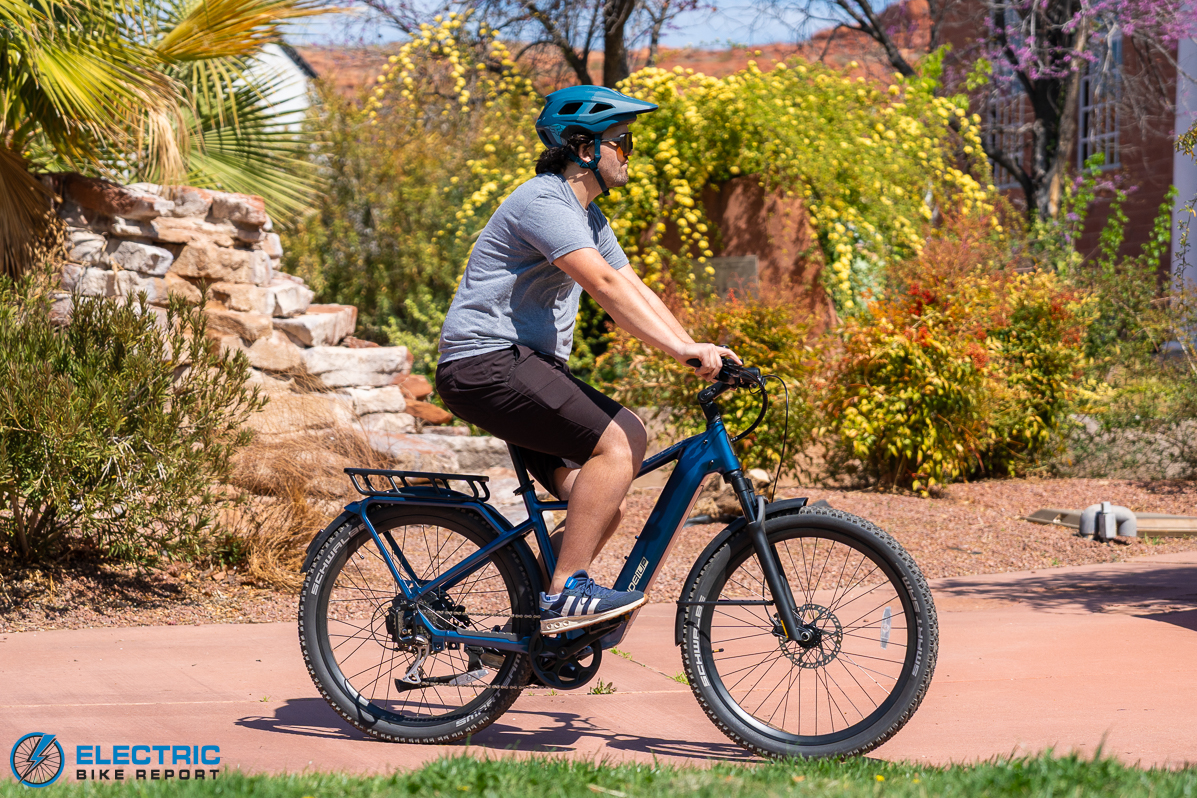
The Vrosa is a stylish ride with nice handling for going through the city on a daily commute.

One of Ride1Up’s most powerful motors to date (on a commuter-style bike), the AKM hub motor can flatten the steepest hills.
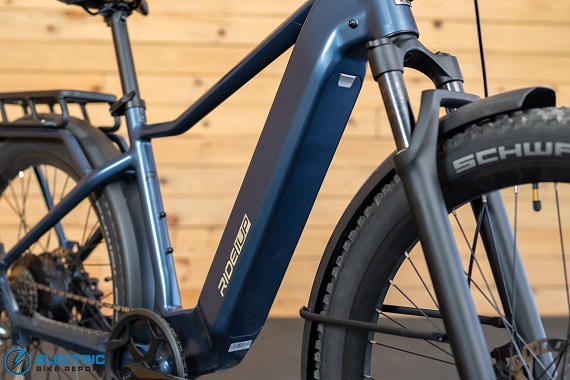
The 720Wh battery is removable for charging off the bike, and the electrical system has both UL 2271 and 2849 certifications.
Ride1Up Vorsa Review: Speed Test
Torque sensors are prized for their intuitive ride feel, adjusting power output based on how hard you pedal. Cadence sensors, on the other hand, deliver power as long as the cranks are turning—making it easier to hit higher speeds, though the experience feels a bit less natural.
Right out of the box, the Vorsa’s torque sensor settings feel fantastic. It delivers all the hallmarks of a great ride: natural engagement, smooth yet responsive acceleration, and the ability to hit and maintain higher speeds. Check, check, check.
Ride1Up’s Intui-Drive torque sensor is impressive. Every year, the performance gap between mid-drive motors and hub motors with torque sensors is narrowing, and this system brings them even closer together in terms of delivering a natural ride feel.
The cadence sensor experience can be solid—but requires some tuning. Ride1Up’s system not only lets you choose your sensor type but also allows you to adjust power and torque settings for each of the five assist levels. However, swapping sensors doesn’t automatically adjust those settings, and as the bike ships, it’s more optimized for a torque sensor experience than a cadence sensor one. If you plan to ride with a cadence sensor, I’d recommend dialing down the power settings for a smoother ride.
After tweaking the power levels in ~20% increments, the bike felt great and delivered distinct speed differences across assist levels.
One standout feature of Ride1Up’s wattage-based cadence system (R1CBC) is that it doesn’t rely on a hard stop at a preset MPH. This prevents the ride from feeling jerky when the motor cuts out, which can be an issue on some cadence-sensor-driven bikes. The acceleration still leans on the quicker side, but with some power adjustments, there’s a sweet spot for everyone.
Looking ahead, one feature we’d love to see is the ability to save multiple power profiles. I fully acknowledge that the majority of people are likely to set the power once and likely never touch it again.
But still, it would be nice as it would allow riders to keep optimized settings for both torque and cadence sensors—or even have different profiles on a single sensor, switching between thrill rides with max power and battery-saving modes for those days when you need to stretch your range, without the need to adjust power on each individual PAS level.
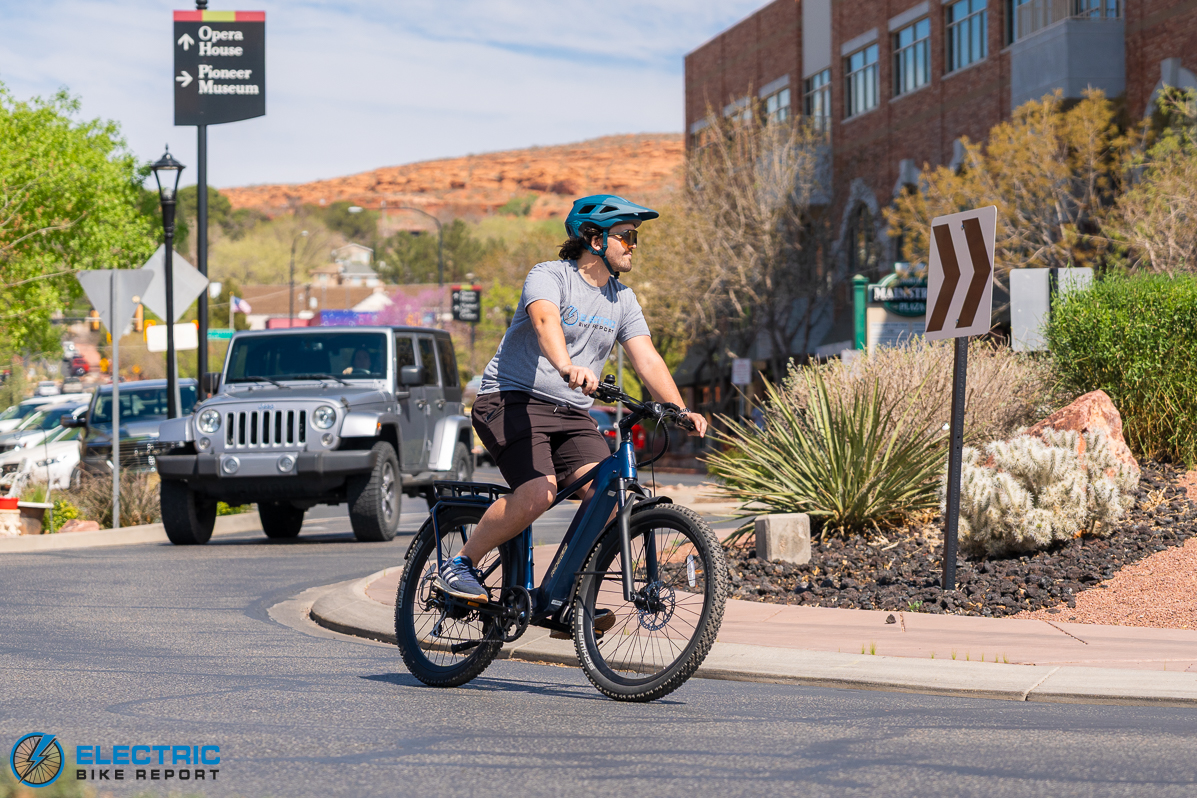
The Vorsa can easily move you through traffic thanks to a peppy motor experience on either torque or cadence sensor programming.

The Shimano drivetrain provides a nice range that doesn’t feel undergeared for higher-speed riding.
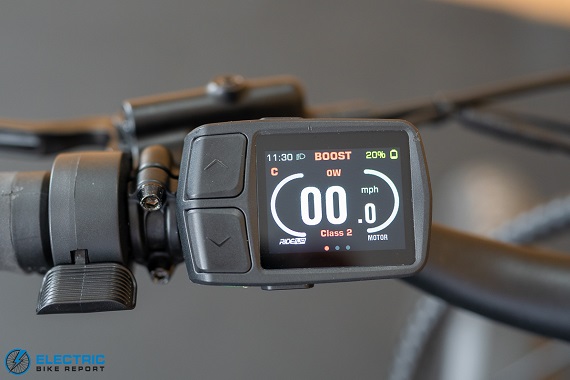
The Vorsa’s display is color-coded for PAS levels and is the key to unlocking several programming options
Ride1Up Vorsa Review: Range Test

Well, have yourself a day, Vorsa!
The Vorsa exceeded its range expectations—by a lot. Ride1Up quotes a range of 30-60 miles, but our tests blew past that, reaching 42.56 miles on max power and 92.42 miles on minimum power.
This was one of the most efficient range tests we’ve seen from Ride1Up. When stacked against other commuter e-bikes with hub motors, the Vorsa ranks among the top all-time performers in watts-per-mile efficiency (think of it like miles per gallon for a car). So, how did it pull that off?
For starters, we tested the bike using the torque sensor instead of the cadence sensor. In general, torque sensors are more efficient because they adjust power output to match the rider’s effort, rather than delivering a set amount of assistance like cadence sensors do.
The tires also played a role. Initially, I thought the knobby tread of the Schwalbe Smart Sam tires might slow it down, but they’re actually optimized for mixed road and dirt performance. The denser center lugs improve rolling efficiency on pavement, while the outer blocks provide grip when riding on dirt.
Overall, the Vorsa moves efficiently and doesn’t require much power to maintain speed. However, lets temper expectations just a bit: if you crank it up to Class 3 speeds or switch to the cadence sensor, expect results to land closer to Ride1Up’s official range estimate.
Still, we tested the Vorsa under the same conditions as other e-bikes—and compared to its peers, it outperformed most of them. Simply put, we were more than happy with the mileage it achieved.
Ride1Up Vorsa Review: Hill Test
First, a quick caveat: While we kept most settings the same, we did notice that Boost mode torque ships at 85% by default. To let the bike give it everything it’s got, we bumped it up to 100% before testing.
With 95Nm of torque and 1,380W of peak power, the Vorsa has serious muscle. Its throttle is powerful, but when you pedal, it really flies.
On our hill test, the Vorsa reached the top in 1:19 (13.7 mph) on throttle alone and 1:04 (16.9 mph) when pedaling. At the time of testing, those results put it in third place for throttle-only and first place among all commuter e-bikes we’ve tested. Yowza!
Clearly, this bike is well-equipped for steep hills, making them feel effortless. Breaking new ground as a category leader is an achievement in itself, but it also feels fitting for a bike as versatile as the Vorsa.
Most e-bikes that outperform commuters on our hill test fall into three categories: all-terrain models (which aren’t far from dirt bikes and typically pack over-the-top motors), moped-style (built like lightweight motorcycles), and cargo e-bikes, which are designed for heavy hauling with high-torque motors. Most commuter e-bikes get by with 60-80Nm of torque, but the Vorsa cranks it up to 95Nm—on par with cargo e-bikes.
This isn’t just about setting fast times on hills—it’s about having the power to haul heavier loads effortlessly. Cargo e-bikes often dominate hill tests, even when we’re not carrying weight, simply because they’re built to perform under load. The Vorsa takes a similar approach, making it one of the most capable commuter e-bikes for climbing.
Bottom line: Hate hills? No problem. Whether you throttle or pedal, with or without cargo, the Vorsa takes them on with ease.
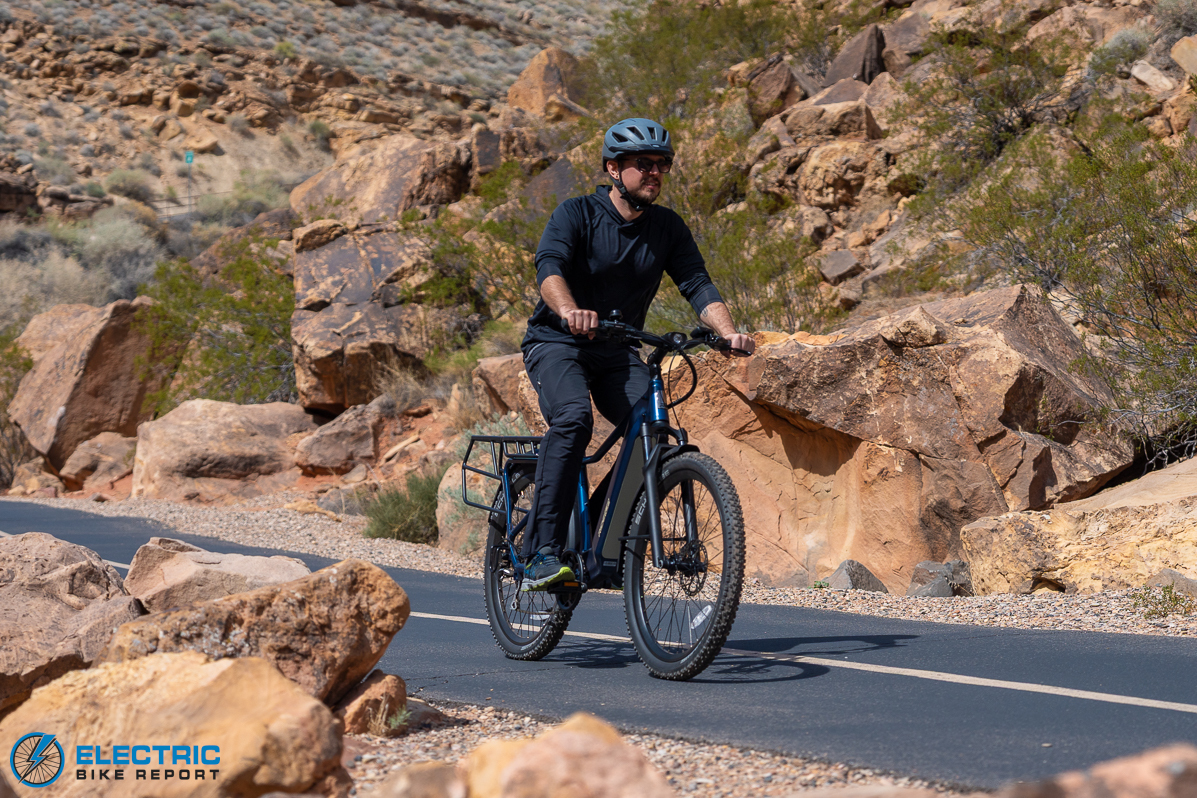
From bike path to the unbeaten path, the versatility of the Vorsa holds a lot of appeal.
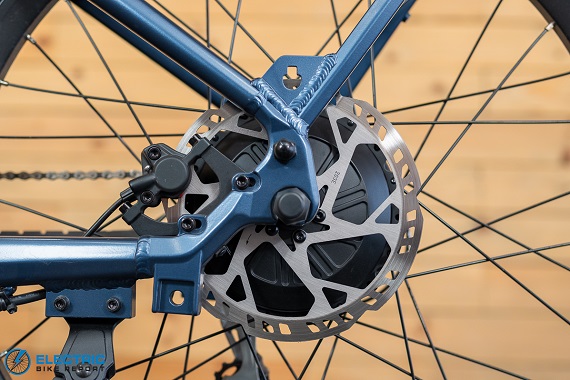
It’s rare to see the larger brake rotor at the rear of the bike, but it might be more practical to slow down the bike for those who max out the payload.
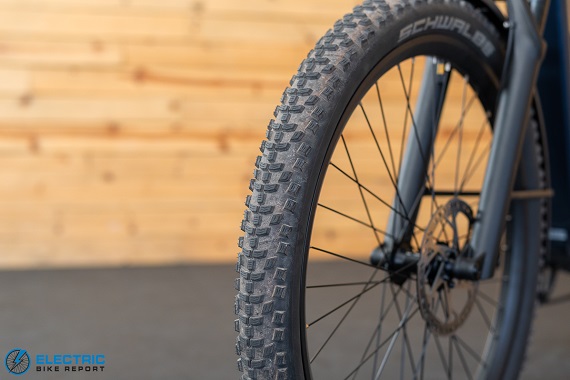
Schwalbe’s Smar Sam tires roll surprisingly well on paved surfaces, with enough teeth to bite into loose terrain when you go exploring.
Ride1Up Vorsa Review: Brake Test

Ride1Up has taken an atypical approach to its braking setup. The Vorsa comes with 2-piston hydraulic brakes, featuring a 180mm rotor on the front and a larger 203mm rotor on the rear. Normally, when rotor sizes are mixed, the larger rotor is placed up front, since braking force is roughly a 70/30 split between the front and rear, allowing for quicker stopping power.
So why did Ride1Up opt for a larger rotor on the rear wheel instead? The primary advantage is better heat dissipation, which is useful when riding the brake to control speed under a heavy load rather than for all-out stopping power. Our testing supported this logic—the setup proved safe and effective, though not record-breaking in performance.
In our brake test, the Vorsa stopped in an average of 22’6″, which is just a few inches longer than the commuter average and nearly a foot longer than the overall e-bike average. While not the absolute best, it’s still a good score and falls well within safe parameters.
So why not put the larger rotor up front for a better result? Truthfully, it’s not entirely necessary. Ride1Up could have easily gone with dual 180mm rotors and called it a day. Instead, the 203mm rear rotor suggests they’re taking the cargo-carrying capability seriously, ensuring the bike is set up for success under load.
Alternatively, this setup could be about adventure riding too. When descending on loose terrain, you generally don’t want to lean too far forward. Without a dropper post, some riders may prefer shifting their weight back and relying more on the rear brake for control.
In either case, riding the brakes for extended periods with a heavy load can lead to overheating, pad wear, and rotor issues. It seems like Ride1Up designed this setup to brace for all scenarios, whether it’s hauling cargo or tackling varied terrain.
As for overall braking performance, the Vorsa delivers reliable stopping power for slowing, controlling, and coming to a full stop.

The 100 lux headlight helps keep you seen when riding at night.
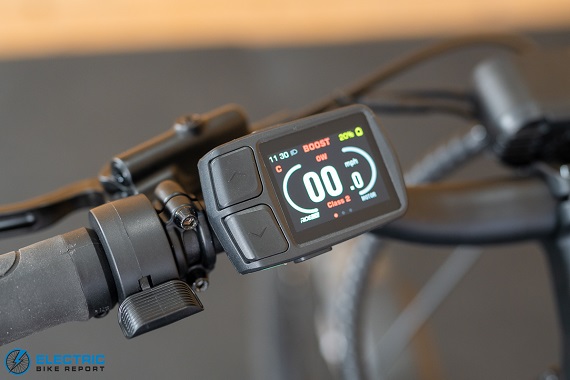
The thumb throttle has some modulation for cruising or for blasting full motor power.
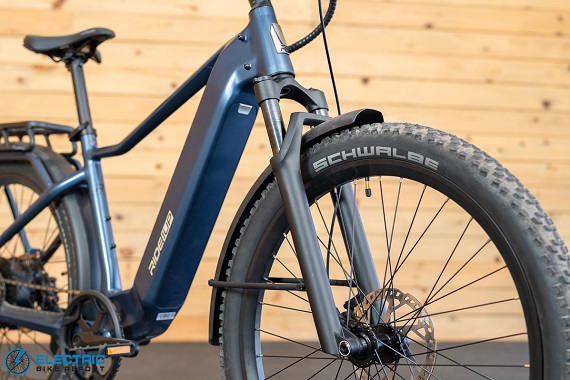
The fork is on the budget-end of the spectrum, but performed fairly well after the preload was dialed in.
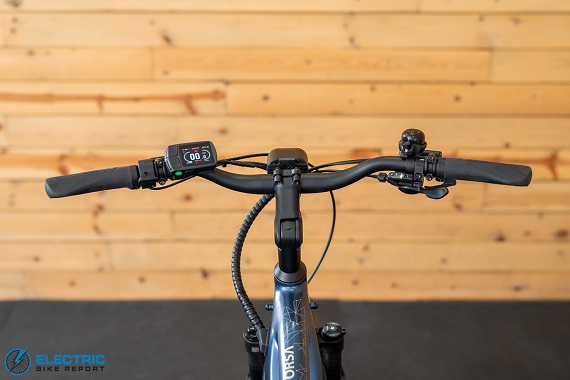
The 680mm bar feels wide enough to fit different parts and not feel cluttered, but is narrow enough to make the handling feel livelier.
Ride1Up Vorsa Review: Ride Quality
If we were to compare them to cars, the Vorsa lands somewhere between a Jeep Wrangler (rugged, off-road capable) and a Honda CR-V (built mainly for city comfort). I’d place it in the middle—think Subaru Outback or Toyota 4Runner. Let me explain.
Some bikes, like the Specialized Turbo Tero X, lean heavily into mountain bike elements and are capable of singletrack riding but just need a few accessories to double as commuters. Others, like the Tenways Ago X, have just enough off-road capability but are clearly designed for comfort on pavement first.
The Vorsa sits in between—great for exploring campsites and mild hardpack trails, but primarily built for comfort and utility on the road. Its cargo rack and carrying capacity add to its versatility, making it useful for a variety of tasks.
I’m a big fan of Schwalbe tires, and the Smart Sams are a perfect match for this bike—grippy and wide enough for handling loose terrain like sand while still rolling smoothly and efficiently on pavement.
The Exsho spring fork is entry-level, but with 100mm of travel, it smooths out rough roads and doesn’t bottom out over every little bump, so it doesn’t feel cheap, either.
The XR frame is well-executed for a one-size-fits-all design, and it has a sleek, polished appearance—something Ride1Up consistently nails. Their paint jobs always look great.
With a 680mm handlebar, the Vorsa feels lively and responsive, while the adjustable seat post and stem allow for a comfortable fit for most riders.
I haven’t fully maxed out the rear rack yet, but I’ve ridden with around 40 lbs of gear, and the bike handled it well. If you load it to its full capacity, keep in mind that the larger tire diameter raises the center of gravity, which takes some adjustment compared to a standard cargo bike. The motor isn’t loud, but it becomes slightly more noticeable when carrying heavier loads.
One thing I appreciate is Ride1Up’s commitment to cargo capabilities. The standard rear rack is unique—its 150 lb capacity is higher than most detachable racks. With the extension, the max weight jumps to 180 lbs. Ride1Up is also introducing a full lineup of cargo accessories, including child seats, passenger packages, and grab rails. My contacts there have hinted that this is just Version 1.0 of the rear rack—a Version 2.0 is in the works, featuring a one-piece design capable of carrying two kids.
The Vorsa gets the little details right, too—a slap guard on the chainstay, an integrated rear light within the fender, and multiple mounting points for two water bottles are all welcome additions.
Touchpoints like grips and saddles come down to personal preference, but given the bike’s versatile nature, I think Ride1Up chose well—they offer a nice balance of comfort and support.
The color display is a highlight—clear, easy to read and shows all the essential ride data like power level, battery life, and speed. But the bigger deal is how easily you can adjust the bike’s settings.
Fine-tuning the motor’s speed isn’t new for Ride1Up, but this is the first time the process feels intuitive. Past models could be tricky to navigate without an owner’s manual handy, but now, it’s straightforward to adjust power, torque, and sensor preferences. Dialing in your ride to match your comfort level is an underrated feature, and I’m happy to see the Vorsa bringing that level of customization into the Ride1Up lineup.
The cherry on top to the bike is some included security. The bike comes compatible with FindMy GPS tracking, so iPhone or Apple ecosystem users can have a little backup insurance if anybody tries to run off with the ride.
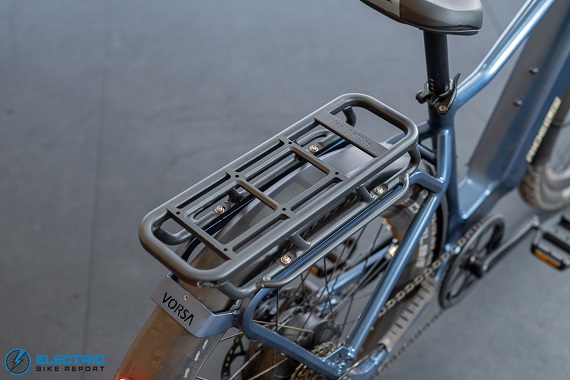
The frame-mounted rear rack has a high weight capacity, but can be removed for a cleaner aesthetic of for off-road riding.
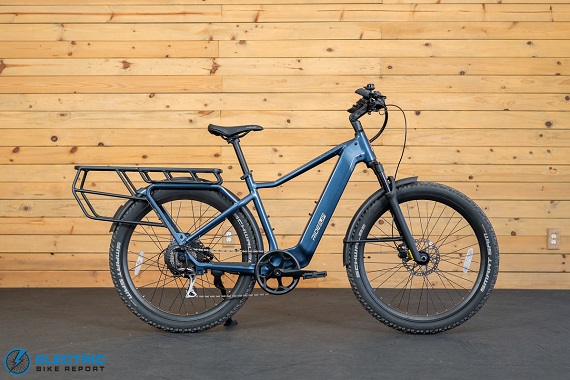
The unique rack extension ups the carrying capacity to 331 lbs (!).
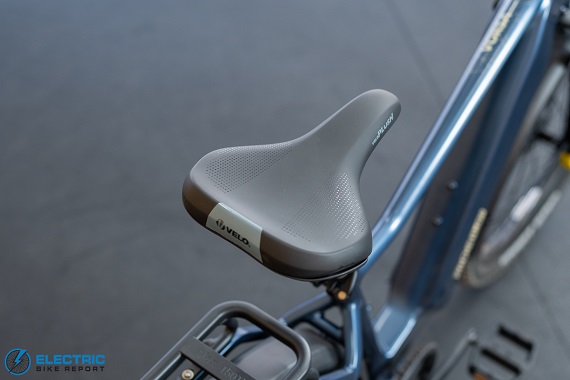
The Velo saddle is equal parts sporty and cushioned.

The rear fender comes with a taillight/brakelight built-in.
Ride1Up Vorsa Review: Summary / Where to Buy
My biggest takeaway? Surprise. Not that it was fun—we’ve consistently been impressed with Ride1Up’s other bikes—but rather how well it performed across the board. It manages to do a lot while keeping the price affordable.
Its test scores ranged from solid to stellar. But among all the SUV-style e-bikes I’ve tested, nothing comes close to the Vorsa’s cargo-carrying capacity—it’s redefining what a jack-of-all-trades e-bike can be.
Aside from the lack of programmable power profiles and some limited sizing options, there’s not much to critique. Ride1Up has built a well-executed bike that offers something for everyone—often more than you’d expect.
Happy Riding! Make sure to let us know if you have any questions or if you think we left anything out in this review of the Ride1Up Vorsa down in our comments section.



How would you compare this to the LMTD v2 as a commuter? Looks like it is 15lbs heavier and has some different components but hard to tell which are better or worse. Is the display noticeably better? How about the brakes (Star Union vs. Tektro) or the front fork? I do wish they included a USB port in the display. Thanks!
Both are color displays. I find the older KD218 on the LMT’d is easy to read on sunny days. I don’t know if polarized sunglasses make it hard to see.
The new display on the Vorsa has a USB-C port on the lower face, per Electric Bike Review’s review.
I have a Vorsa on order and a first-gen LMT’d. From just the reviews, here are the main differences:
KD218 lets you set the number of assist levels from 0/1-3, 5, 7 or 9. Vorsa has only 0-5.
Vorsa’s has off-road mode
Vorsa’s has a USB-C port
Vorsa’s has Apple FindMy
Vorsa’s has easier to understand labels for settings
KD218 lets you set battery display to % or voltage, next to the battery graph, both of which are always displayed in the riding screen. You have to dig into settings menu on the Vorsa for battery voltage.
4 vs 3 buttons. I think the Vorsa’s will be easier to use, both due to having one more button and also it has only the up and down buttons on the front face, which are larger and easier to discern by feel. On my KD218, I sometimes push the center button instead of the up or down button when trying to change assist level without looking as all three are about the same size, and boy, are they hard to push correctly when I’m wearing winter gloves.
HI Griffin –
Tks very much for the report here and the riding tests.
I live in a 2nd story condo, so am VERY conscious of the bike’s weight. I currently have Ride1Up’s Roadster V3 which for me at 70 years old with some hip issues, is quite easy for me to get up the stairs. I live in Seattle, so the Roadster is somewhat limited in its climbing performance. From this standpoint, the Vorsa would be great for me. I would sell the Roadster. My big hesitation with the Vorsa is its weight.
Could you please do a tested weight of the bike with the following conditions (even with the Roadster, I always remove the battery before going up my stairs):
The battery removed (what is its weight?)
The rear rack removed (what is its weight?)
I’m guessing that with the above conditions, it should be in the low 60’s.
Thanks very much for your time and attention.
Mark
Ride1Up updated their measurements chart for the Vorsa with weight without included add-ons, which I assume are the removable part of the rear rack and its fenders (guess you lose the taillight as a result). So 65lbs without those, and this site’s sister site, Electric Bike Review, measured the battery weight as about 8lbs. So the bike would be around 57lbs without the rack, fenders and battery, or ~62 with rack and fenders but no battery.